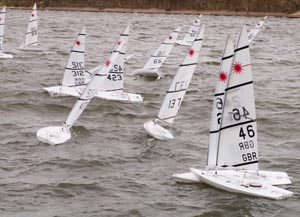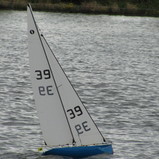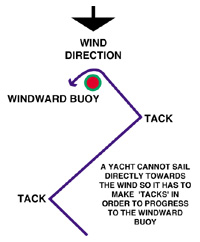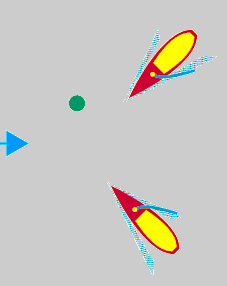|
Who
Looks After the Sport?
The sport is administered in the UK by the Model Yachting Association
(MYA), the division member for the UK of the International Sailing Federation,
International Radio Sailing Association. Search the WWW for the model yachting association
in your country - most countries have one, although its name may be
different to that of the UK's national body.
The Rules
Racing follows the same rules (The Racing Rules for Sailing frequently
referred to as the RRS) as those used in full sized
yacht racing (see animation below)
- with a few minor changes to account for the fact that helmsmen are
not in the yacht but on the shore. A copy of the RRS can readily be
purchased from any good book shop. A Rules Companion published by Fernhurst
Books is shown i n the illustration below. When ordering be sure to
obtain the latest issue as the rules are updated every five years.
The
Course Most races follow the standard 'Olympic' course (see
diagram I) using three buoys set out in a
triangular arrangement as shown.
The
second illustration (diagram II)
shows how an arrangement of eight buoys allows a course to be set for
any wind direction. This layout was used in the 1968 Acapulco Olympics.
The purpose of the 'Olympic' layout is to ensure skippers' skills are
tested on all points (directions to the wind) of sailing.
The
Beat to Windward
After the start skippers are faced with a 'beat' against the wind which
will involve tacking the yacht a number of times before reaching the
windward buoy. The course therefore actually sailed to the windward
buoy takes the form of a zig zag and not a straight line as shown (see
diagram III). The beat is a very tactical
part of the course - many places can be won or lost on the beat.
The Broad Reach
After rounding the windward buoy the yachts sail a 'broad reach' which
is the fastest direction, relative to the wind, a yacht can sail.
The Gybe
At the wing buoy the yacht has to 'gybe', which in full sized yachting
is the one of the most dangerous manoeuvres a yacht can make. The manoeuvre
requires great skill to effect safely and efficiently. A gybe causes
the main sail to 'flip' violently from one side of the yacht to the
other.
The Second Reach and Beat
The gybe is followed by another broad reach down to the leeward buoy
where the yacht begins another beat up to the windward buoy.
The Run and Final Beat to the Finish
After rounding the windward buoy a second time the yacht now sails dead
downwind on a 'run' to the leeward buoy before beginning their final
beat to the finish line.
How
to Win Races
To win races a number of quite different 'qualities' are required:-
- A
fast boat
- Good
quality sails and an understanding of how they work (read a good book
on the subject)
- A
sound knowledge of the racing rules (buy a good book on the rules)
- An
understanding of race tactics (there are some good full-size yacht
racing videos available)
- Optimum
rig/sail trim for all 'legs' of the course
- A
good start - i.e. on time and in a good position when the start horn
sounds
- Lots
and lots of practice
- Some
luck
Radio
Control
Yachts are controlled by a handheld radio transmitter (see
illustration) sending instructions to an onboard
receiver. The radio signals are used to control a variety functions
depending on the class of yacht being sailed. For example, the International
One Metre Class allows only the rudder and sails (main and jib together)
to be controllable from the shore (see control diagram).
Other classes allow more controls including sail trimming devices such
as backstay adjustment or, in some classes, even a spinnaker.
Three control frequency bands are commonly used for yacht racing in the
UK. These are the 27MHz band (12 transmitting channels) and the 40MHz
band (34 transmitting channels) and 2.4GHz (80 channels). The last is
steadily gaining in popularity as the equipment finds and selects a
channel for itself. Regattas are usually organised in such a way that no
more than 20 boats compete
in any one race. This does not restrict the number of entries, as a
multiple fleet system, with promotion and relegation is employed when
regatta entries exceed 20 boats.
Feel Up to the Challenge? Then What Next?
Study the rest of this site. Then visit the MYA
Web Site for the UK (or your own national body) to find a club in
your area.
Happy Sailing -
It's
a great sport. Racing is fun, although it can get a bit frantic at times,
especially when racing against 17 other boats.

Collisions
like this are rare in rc yacht racing as the rules make it quite clear
who has the right of way and who should be taking avoiding action. We
can only guess why boat number 46 got itself into this position but
it's all good fun and these boats are robust enough to be able to withstand
this kind of 'accidental contact'.
|







